
| Singalila Ridge Trek |
|
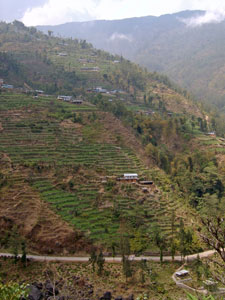 Terraced gardens of the Darjeeling Hills |
|
|
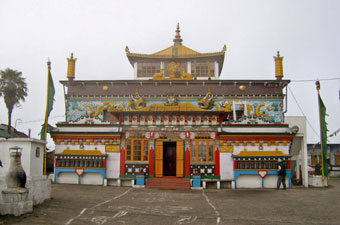 The Yiga Choeling Monastery built in 1875 |
|
Rimbik to Siri Khola
|
|||
|
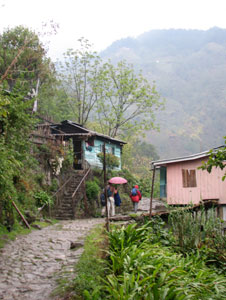 Passing through suburban Rimbik |
 Descending toward the Siri Khola |
|
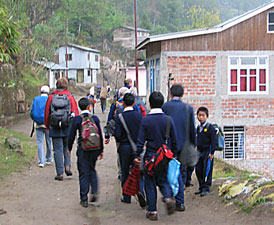 Trekkers and school children heading off from Rimbik |
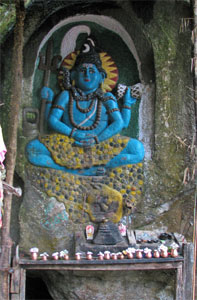 Roadside shrine |
||
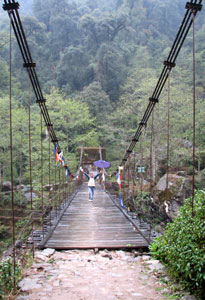 Wangchuk crossing the Siri Khola |
After a short descent of 4 km traversing the steep slopes, we crossed a suspension bridge over the rushing waters of the Siri Khola to reach the Goparma Hotel, our spartan but comfortable lodgings for the night, and to enjoy the first of our nightly three-course dinners, rich with the flavours of India and Nepal. Glad not to be camping out in the rain, we fell asleep listening to the waters of the Siri Khola rushing down on their path to the mighty Ganges. |
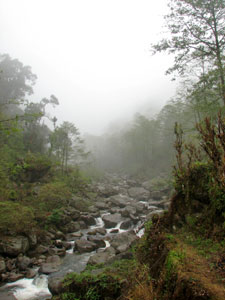 The evening mists settle over the Siri Khola Valley |
|
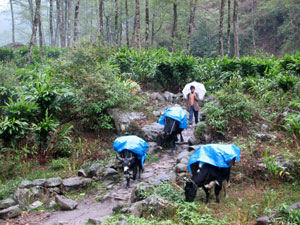 Dzos passing through the cardamon fields |
 Our first orchid |
||
|
||
 Mists rising over the terraced hillsides |
Following trekking tradition, we were woken with a hot cup of tea at 6 am, served a hearty breakfast of porridge, eggs and croissants at 7 am and set off again at 8 am. Such would be the pattern of each day. The overnight rain had cleared leaving a misty morning behind as we climbed quickly up along a daisy-lined path through garden terraces of potatoes and peas that traversed these lower slopes of the Singalila Ridge. |
 Spot the mystery fifth trekker |
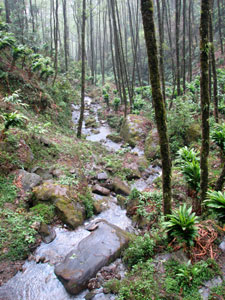 Stream through the cardamon plots |
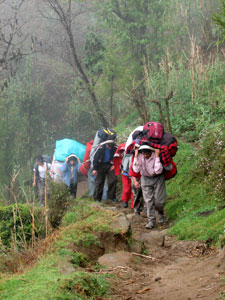 Step aside - porters coming through! |
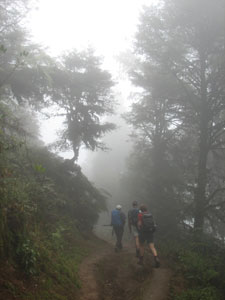 Once more into the ghostly mist |
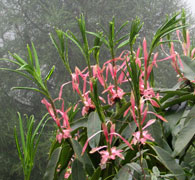 Vivid colours of a long-leafed rhododendron |
Soon we entered a mixed broadleaf forest, which gradually changed into a zone of tall conifers, as a dense fog settled down to create a landscape of ghostly shapes. Reaching the village of Ramman, we stopped for a tea-break in a Nepalese teahouse and were greeted by the sun and the local school children on our emergence. I have always marvelled at how a little bit of sun can lift the spirits. Even the birds seemed to sing louder as we headed off, traversing across a slope of gnarled lichen-covered oaks, the yellow orchids drooping from high on their trunks complementing the brilliant pink and red colours of the first rhododendrons in bloom. |
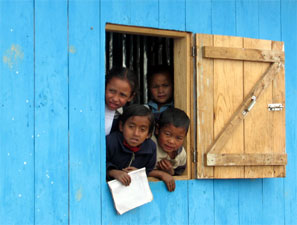 "Namaste!" |
 Into the deep Singalila forest |
 Yellow orchid high on lichen-draped tree trunk |
 A mossy-rock filled stream |
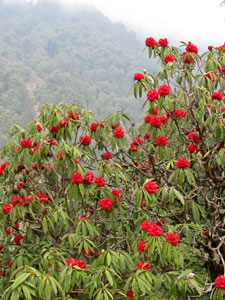 The luminescence of a red rhododendron |
|
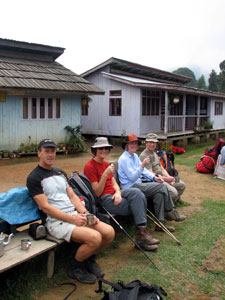 Nothing like a nice hot lemon drink when you arrive! |
|
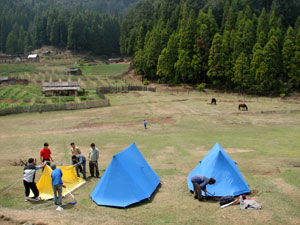 Setting up the tents at Samanden |
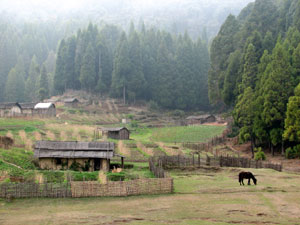 Bucolic bliss |
|
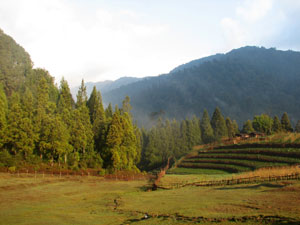 A brief sunny interlude |
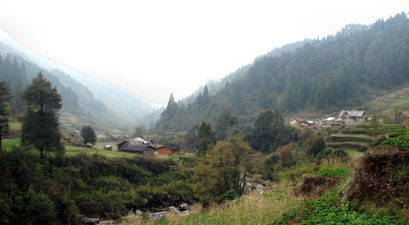 The village of Ghorkey sleeping in the mists of the Ramman Valley |
 Mountain stream near Ghorkey |
|
||
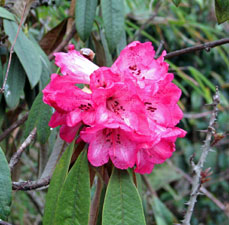 |
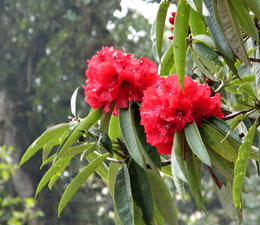 |
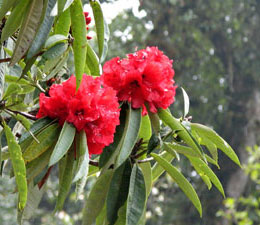 |
 |
|
||
|
|
|
 Climbing up through the prayer flags of Ghorkey |
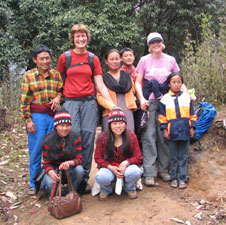 Nello and Hazel with the Sherpa family von Trapp |
|
At 2900m, the track flattened out and followed the crest of one of the ridge spurs through a forest of tall lichen-covered oaks and monkey nut trees with an understorey of dense bamboo thickets. This was red panda country and, somewhere high in the trees well out of sight, the red pandas were sleeping. |
|
 Red panda country |
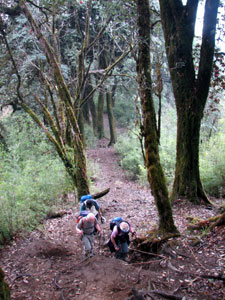 Steep climb up the Singalila spur |
 The track meanders beneath red and pink rhododendrons |
|
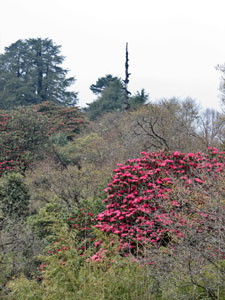 Rhododendron lighting up the forest |
||
 |
 |
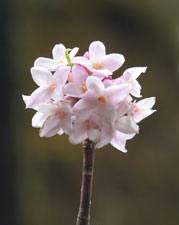 |
||
|
At 3250m we stopped for lunch and, as we ate, the wind gradually picked up, whipping streams of cloud through the trees on the top of the spur. Climbing on, we emerged into an open grassland, splashed with a dash of pinkish-purple primulas, and were soon enveloped in a thick fog. As the wind strengthened, Wangchuk led us across the foggy landscape to our destination at the Indian army border post of Phalut (3505m); the big climb was over! The porters had just set up our tents and, after a hot tea and rum (courtesy of George), we climbed into our tents for a nap. Well that was the plan; during the next two hours we experienced hail, followed by gale-force winds, a fierce thunderstorm, and finally a blizzard. |
|
|
|
|
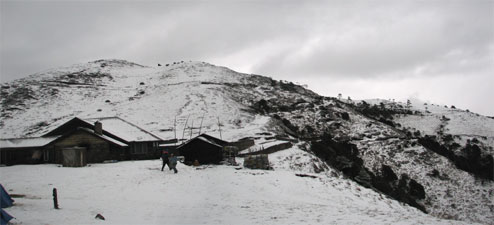 The bleakness of the trekker's hut at Phalut |
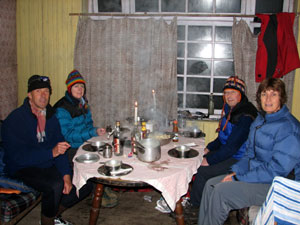 Hot soup and momos at the Ritz-en-Phalut |
|
 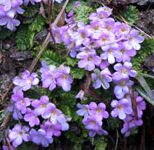           |
|
||
 Setting off from Phalut |
Of these views I can offer no comment! For us the Singalila Ridge was an ethereal world of dense fog, icy winds that whipped over the ridgeline from Nepal, rain, sleet, hail and snow. Walking 21 km from Phalut to Sandakphu in these circumstances was a surreal experience. |
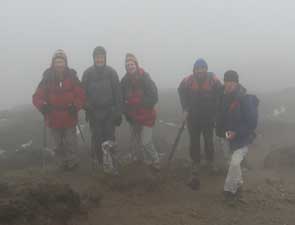 Photo stop on the Nepalese border |
 The sweeping panorama across Nepal to the Himalayan Chain, as viewed from the Singalila Ridge - well the brochures did say that the sky was not as clear in spring! |
||
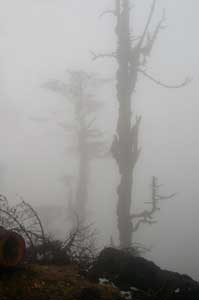 The ghostly shapes of trees in the fog |
It seemed that we were walking through the dense fog in a slow-moving bubble with a 30-40m radius of visibility; there was no real perception of distance or depth, at times the ground would slope up, at times down, at times it was flat. The strange ghostly shapes of trees faded in and out of our bubble, the stark silhouette of the odd grazing yak or dzo appeared and disappeared. Even the occasional display of a flowering rhododendron failed to lift our spirits. At that moment, I would have traded a million rhododendrons for one brief glimpse of Kangchenjunga!
|
 Even the rhododendrons failed to lift the gloom |
|
|
|
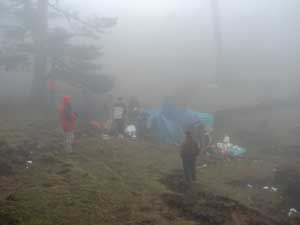 Kalu and his team preparing a hot lunch in the cold fog |
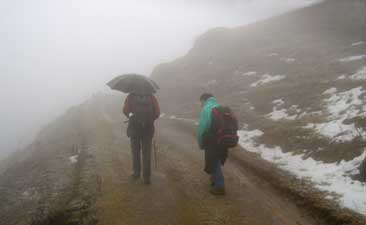 And just when it couldn't get any worse down came the hail! |
|
|
Sandakphu to Tumling - a taste of Nepal |
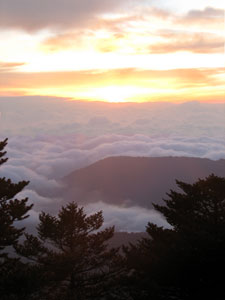 Sandakphu sunrise |
|
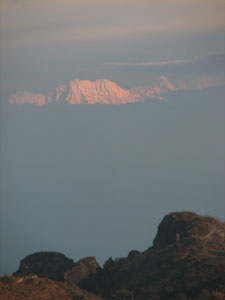 120km across Nepal to the northeast the sun illuminated part of the Himalayan chain |
 The mystical profile of 7710m Jannu |
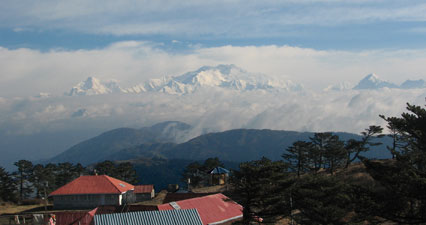 Kangchenjunga basks in the morning sun above the red rooves of Sandakphu |
|
||
 At last the sun shone on the Singalila Ridge showing yesterday's path from Phalut |
|
As we ate breakfast, the cloud began to rise up from the valleys and by the time we set off, was drifting across the low points of the ridge line. We quickly descended a stony road, surrounded by the the dense green forest of the Singalila National Park. The rhododendrons seemed to be particularly beautiful this morning as whisps of cloud blew through from the Nepalese side of the ridge. Reaching the village of Bakhay, we followed the road into Nepal, traversing the western side of the ridge through several small Nepalese mountain villages, and looking down into the deep valleys of eastern Nepal below us. |
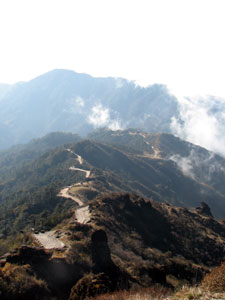 Singalila track heading south from Sandakphu |
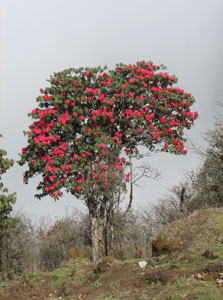 Another glorious red rhododendron |
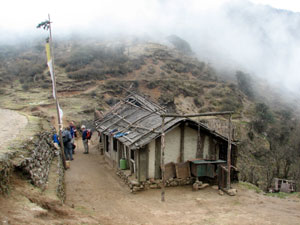 Nepalese teahouse at Bikhebhanjang, below Sandakphu |
Descending slowly, the track led us through the superb forest on the Indian side, with rhododendrons, and the occasional brilliance of magnolias, lighting the way. A steep descent to the village of Gairibas saw us reach our lunch stop and passport check by the border post. |
 Wangchuk and our host in the teahouse at Kalapokhari |
 Sorry, I couldn't resist .... |
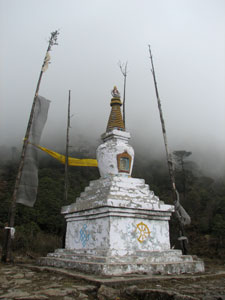 Roadside chorten |
 Magnolia blooms in the forest |
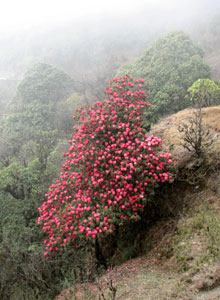 Just another pink rhododendron tree lighting up our path |
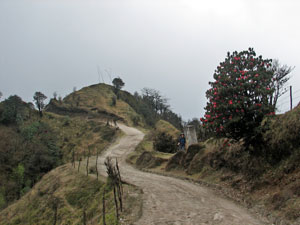 Left side, India - right side, Nepal |
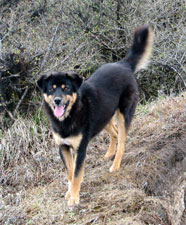 A fellow trekker who joined us for a few kilometres |
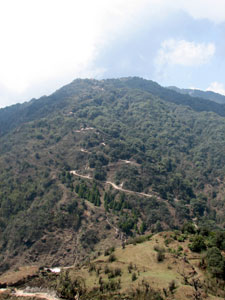 The climb up from Gairibas to Jaubari |
|
||
 The porters' having a rest break |
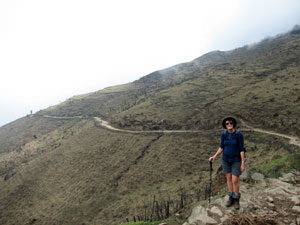 Where have all the trees gone? - Nepalese side of the ridge |
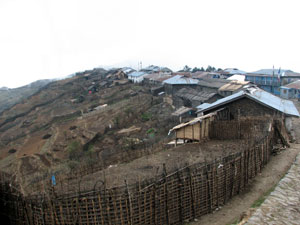 The village of Jaubari on its barren ridge |
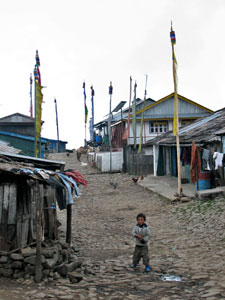 |
 |
 |
Still, the villages are all full of young children and you can't help wondering what the future holds for them. |
The main street of Jaubari and some of its residents |
|||
 The lonely shell of the Jaubari police station - destroyed by Maoists two years earlier |
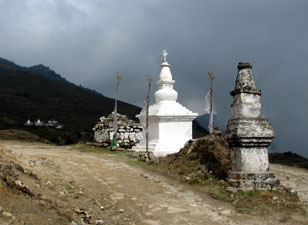 Mane wall and chortens near Jaubari |
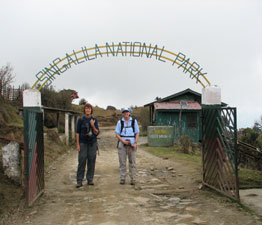 Nello and Hazel at the National Park gate |
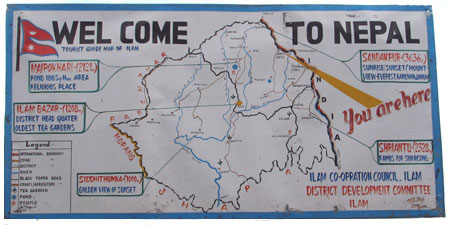 |
One more zig into India, one more zag into Nepal and we reached our destination for the night, the very pleasant Shikhar Lodge at Tumling, with its large comfortable bedrooms and fire-warmed lounge. Sitting around sipping our warm millet beers through a large straw, we agreed that this had been the best day of the trek. We were even weaning ourselves off the immodium. What a difference a day makes! |
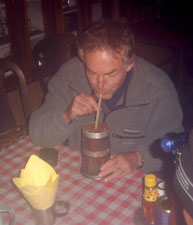 |
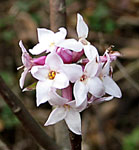 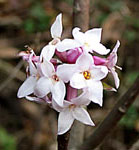         |
|
||
|
The tip of Kangchenjunga rose faintly above the low cloud band, but that was all that we would see for the day. Still, the view back along the ridge to Sandakphu was magical, with thin wisps of mist drifting over the pastel shades of the ridge and forest in the pre-dawn light. |
|
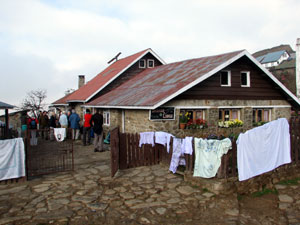 Farewell to the Shikhar Lodge, Tumling, Nepal |
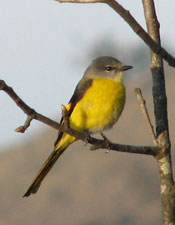 |
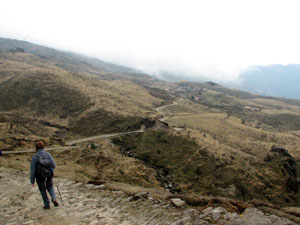 On the road to Tonglu |
|
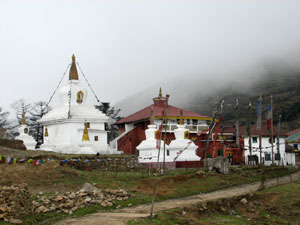 Senchencholing Monastery at Tonglu |
With only 12 km of trek left, we set out along a winding stony road, dropping into the bare Nepalese side once more, climbing slowly back across the ridge into India at Tonglu, with its Buddhist monastery of Senchencholing. |
 Back into the mists near Meghma |
|
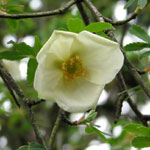 |
 |
||
|
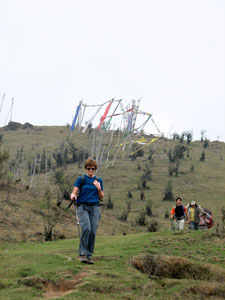 Descending the grassy flats of Meghma |
|
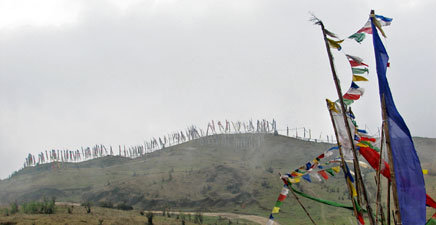 Skyline of prayer flags on the hills near Meghma |
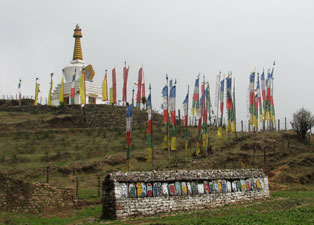 Mane Wall, Chorten and prayer flags at Csitray Monastery |
|
|
||
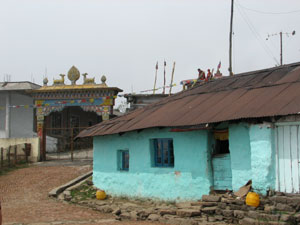 Entry to Csitray Monastery |
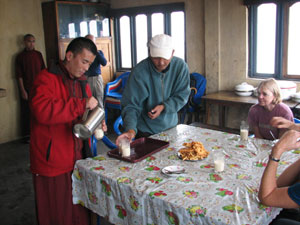 Tea and biscuits are served |
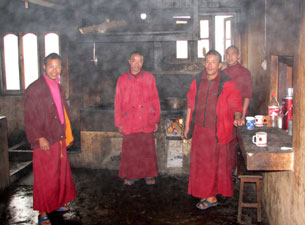 The monks of Csitray in a steamy kitchen |
|